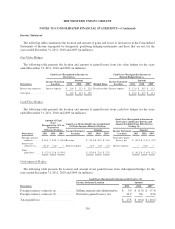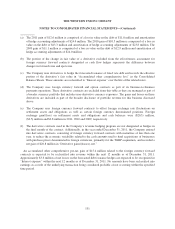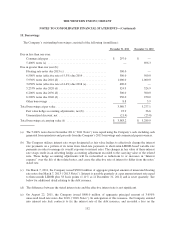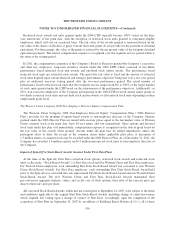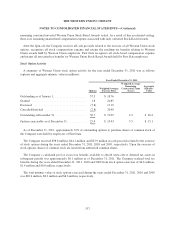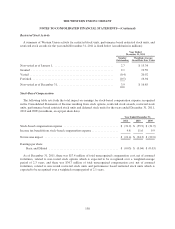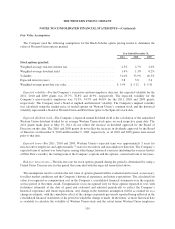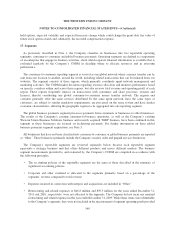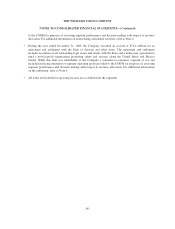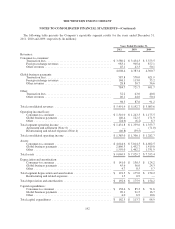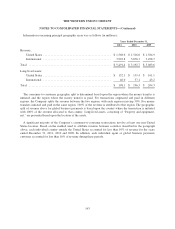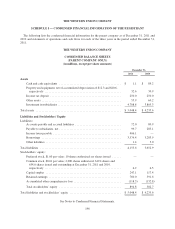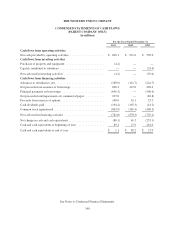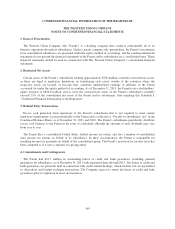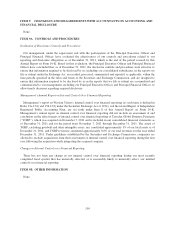Western Union 2011 Annual Report Download - page 147
Download and view the complete annual report
Please find page 147 of the 2011 Western Union annual report below. You can navigate through the pages in the report by either clicking on the pages listed below, or by using the keyword search tool below to find specific information within the annual report.THE WESTERN UNION COMPANY
NOTES TO CONSOLIDATED FINANCIAL STATEMENTS—(Continued)
hold options, expected volatility and expected term may change which could change the grant-date fair value of
future stock option awards and, ultimately, the recorded compensation expense.
17. Segments
As previously described in Note 1, the Company classifies its businesses into two reportable operating
segments: consumer-to-consumer and global business payments. Operating segments are defined as components
of an enterprise that engage in business activities, about which separate financial information is available that is
evaluated regularly by the Company’s CODM in deciding where to allocate resources and in assessing
performance.
The consumer-to-consumer reporting segment is viewed as one global network where a money transfer can be
sent from one location to another, around the world, including related transactions that can be initiated from our
websites. The segment consists of three regions, which primarily coordinate agent network management and
marketing activities. The CODM makes decisions regarding resource allocation and monitors performance based
on specific corridors within and across these regions, but also reviews total revenue and operating profit of each
region. These regions frequently interact on transactions with consumers and share processes, systems and
licenses, thereby constituting one global consumer-to-consumer money transfer network. The regions and
corridors generally offer the same services distributed by the same agent network, have the same types of
customers, are subject to similar regulatory requirements, are processed on the same system and have similar
economic characteristics, allowing the geographic regions to be aggregated into one reporting segment.
The global business payments segment processes payments from consumers or businesses to other businesses.
The results of the Company’s existing consumer-to-business operations, as well as the Company’s existing
Western Union Business Solutions business and recently acquired TGBP business, have been combined in this
segment as these businesses are focused on facilitating payments. For further information on these global
business payments segment acquisitions, see Note 3.
All businesses that have not been classified into consumer-to-consumer or global business payments are reported
as “Other.” These businesses primarily include the Company’s money order and prepaid services businesses.
The Company’s reportable segments are reviewed separately below because each reportable segment
represents a strategic business unit that offers different products and serves different markets. The business
segment measurements provided to, and evaluated by, the Company’s CODM are computed in accordance with
the following principles:
• The accounting policies of the reportable segments are the same as those described in the summary of
significant accounting policies.
• Corporate and other overhead is allocated to the segments primarily based on a percentage of the
segments’ revenue compared to total revenue.
• Expenses incurred in connection with mergers and acquisitions are included in “Other.”
• Restructuring and related expenses of $46.8 million and $59.5 million for the years ended December 31,
2011 and 2010, respectively, were not allocated to the segments. The Company did not incur any material
restructuring and related expenses in the year ended December 31, 2009. While these items were identifiable
to the Company’s segments, they were not included in the measurement of segment operating profit provided
140


